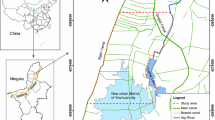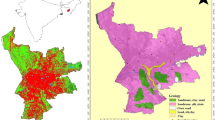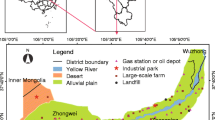Abstract
This study assesses vulnerability of groundwater to pollution in Beihai City, China, as a support of groundwater resource protection. The assessment result not only objectively reflects potential possibility of groundwater to contamination but also provides scientific basis for the planning and utilization of groundwater resources. This study optimizes the parameters consisting of natural factors and human factors upon the DRASTIC model and modifies the ratings of these parameters, based on the local environmental conditions for the study area. And a weight of each parameter is assigned by the analytic hierarchy process (AHP) to reduce the subjectivity of humans to vulnerability assessment. The resulting scientific ratings and weights of modified DRASTIC model (AHP-DRASTLE model) contribute to obtain the more realistic assessment of vulnerability of groundwater to contaminant. The comparison analysis validates the accuracy and rationality of the AHP-DRASTLE model and shows it suits the particularity of the study area. The new assessment method (AHP-DRASTLE model) can provide a guide for other scholars to assess the vulnerability of groundwater to contamination. The final vulnerability map for the AHP-DRASTLE model shows four classes: highest (2%), high (29%), low (55%), and lowest (14%). The vulnerability map serves as a guide for decision makers on groundwater resource protection and land use planning at the regional scale and that it is adapted to a specific area.








Similar content being viewed by others
References
Aller BT, Lehar JH, Petty R (1987a) DRASTIC: a standardized system to evaluate ground water pollution potential using hydrogeologic settings. National Water Well Association Worthington: Ohio
Aller L, Truman B, Rebecca JP, Glen H (1987b) DRASTIC: a standardized system for evaluating groundwater pollution potential using hydrogeologic settings, CR-810715, U.S. GeologicalSurvey, Environmental Protection Agency
Allouche N, Maanan M, Gontara M, Rollo N, Jmal I, Bouri S (2017) A global risk approach to assess groundwater vulnerability. Environ Model Softw 88:168–182. https://doi.org/10.1016/j.envsoft.2016.11.023
Antoine MK, Marnik V, Jean NL (2017) Assessing groundwater vulnerability in the Kinshasa region, DR Congo, using a calibrated DRASTIC model. J Afr Earth Sci 126:13–22
Anwar P and Rao M (2003) Evaluation of groundwater potential of Musi River catchment using DRASTIC index model, in: Hydrology and watershed management, edited by: Venkateshwar B. R., Ram M. K., Sarala C. S., Raju C. Proceedings of the inter-national conference, 18–20, B.S. Publishers, Hyderabad 399–409, 2002
Ben Hamouda MF, Tarhouni J, Leduc C, Zouari K (2010) Understanding the origin of salinization of the Plio-Quaternary eastern coastal aquifer of Cap Bon (Tunisia) using geochemical and isotope investigations. Environ Earth Sci 63:889–901
Denny SC, Allen DM, Journea YJ (2007) DRASTIC-Fm: a modified vulnerability mapping method for structurally controlled aquifers in the southern Gulf Islands, British Columbia, Canada. Hydrogeol J 15(3):483–493. https://doi.org/10.1007/s10040-006-0102-8
Dhar A (2013) Geostatistics-based design of regional groundwater monitoring framework. ISH J Hydraul Eng 19(2):80–87. https://doi.org/10.1080/09715010.2013.787713
Dong L, Zhu YM, Hu QH, Ogura N (2002) Evaluating ground water vulnerability in West Lake Watershed by using DRASTIC model. Chin J Appl Ecol. (02):217–220
Fan Q, Wang GL, Yan WJ, et al. (2007) Discussion of evaluation method of groundwater vulnerability and its case. Journal of Hydraulic Engineering. (05):601–605
Huan H, Jinsheng W, Yanguo T (2012) Assessment and validation of groundwater vulnerability to nitrate based on a modified DRASTIC model: a case study in Jilin City of Northeast China. Sci Total Environ 440:14–23. https://doi.org/10.1016/j.scitotenv.2012.08.037
Huang D (2009) Study on Groundwater Vulnerability in Plain Area of Beijing. Beijing, Capital Normal University
Kazakis N, Voudouris KS (2015) Groundwater vulnerability and pollution risk assessment of porous aquifers to nitrate: modifying the DRASTIC method using quantitative parameters. J Hydrol 525:13–25. https://doi.org/10.1016/j.jhydrol.2015.03.035
Krishna R, Iqbal J, Gorai AK, Pathak G, Tuluri F, Tchounwou PB (2015) Groundwater vulnerability to pollution mapping of Ranchi district using GIS. Appl Water Sci 5(4):345–358. https://doi.org/10.1007/s13201-014-0198-2
Lei J, Zhang SC (2003) Study on the groundwater vulnerability assessment in Tangshan plain area. Acta scientiae circumstantiae. (01):94–99
Liao M, Yan YN, Zheng QL, et al. (2016) Study on specific vulnerability of nitrate in shallow groundwater in Huai River Plain area. J Nanjing Univ (Natyral Sciences). (01):86–95
Lynch SD, Reynders AG, Schulze RE (1997) A DRASTIC approach to ground-water vulnerability in South Africa. South African Sci 93(2):59–60
Maanan M, Ruiz-Fernandez AC, Maanan M et al (2014) A long-term record of land use change impacts on sediments in Qualidia lagoon, Morocco. Int Sediment Res 29:1–10
Nabila Allouche, Mona Gontara, Ikram Jmal (2017) A global risk approach to assessing groundwater vulnerability. Environmental Modelling & Software. 88:168–182
Pacheco FAL, Pires LMGR, Santos RMB, Sanches Fernandes LF (2015) Factor weighting in DRASTIC modeling. Sci Total Environ 505:474–486. https://doi.org/10.1016/j.scitotenv.2014.09.092
Saaty TL (1990) How to make a decision: the analytic hierarchy process. Eur J Oper Res 48(1):9–26. https://doi.org/10.1016/0377-2217(90)90057-I
Sener E, Davraz A (2013) Assessment of groundwater vulnerability based on a modified DRASTIC model, GIS and an analytic hierarchy process (AHP) method: the case of Egirdir Lake basin (Isparta, Turkey). Hydrogeol J 21(3):701–714. https://doi.org/10.1007/s10040-012-0947-y
Shao H, Xu HW, Wang H (2014) Assessment of shallow groundwater vulnerability in Yang-Tai Area based on AHP and GIS. Geomatics & Spatial Information Technology. (2):49–52
Sun CZ, Zuo HJ, Luan TX (2007) Research on groundwater vulnerability assessment of the lower Liaohe River Plain. Journal of Jilin University (Earth Science Edition. (05):943–948
Tiwari AK, Singh PK, De Maio M (2016) Evaluation of aquifer vulnerability in a coal mining of India by using GIS-based DRASTIC model. Arab J Geosci 9(6):1–15
Victorine Neh A, Ako Ako A, Ayuk AR II, Hosono T (2015) DRASTIC-GIS model for assessing vulnerability to pollution of the phreatic aquiferous formations in Douala Cameroon. J Afr Earth Sci 102:180–190. https://doi.org/10.1016/j.jafrearsci.2014.11.001
Wang XJ, Feng GM, Wang LN (2015) Groundwater vulnerability assessment in plain area of Hainan Province. South - to - North Water Transfers and Water Science & Technology. (03):548–552
Wu Xincai (2004) MapGIS Geographic Information System. Beijing, Publishing House of Electronics Industry
Zhou YX, Li WP (2008). Groundwater quality monitoring and evaluation. Hydrogeol Eng Geol. (1):1–11
Zhou CS, Zheng XQ, Zang HF, et al. (2012) A system of qualitative evaluation indicators of groundwater environment capacity and its application. Chin Agric Sci Bull. (29):259–265
Author information
Authors and Affiliations
Corresponding author
Additional information
Responsible editor: Philippe Garrigues
Rights and permissions
About this article
Cite this article
WU, X., LI, B. & MA, C. Assessment of groundwater vulnerability by applying the modified DRASTIC model in Beihai City, China. Environ Sci Pollut Res 25, 12713–12727 (2018). https://doi.org/10.1007/s11356-018-1449-9
Received:
Accepted:
Published:
Issue Date:
DOI: https://doi.org/10.1007/s11356-018-1449-9




